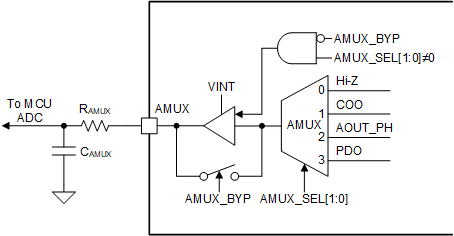SLVAEX3 October 2020 TPS8802 , TPS8804
2.3.2 Photo Amplifier and AMUX Speed
 Figure 2-2 TPS880x AMUX Buffer Schematics
Figure 2-2 TPS880x AMUX Buffer SchematicsThe optimal photo amplifier and AMUX speeds depend on the LED pulse width and ADC sample rate. The photo amplifier time constant τ1 is equal to the gain resistor RPH times CPH. τ1 is adjusted by varying CPH once RPH is selected. The AMUX time constant τ2 is equal to the AMUX buffer resistance RAMUX times CAMUX. τ2 is adjusted by varying RAMUX after setting CAMUX between 330 pF and 1nF. Adjusting the amplifier speeds is an effective way to improve the SNR. This is demonstrated with configurations 3 and 4 in Table 2-1.
The highest SNR for a fixed pulse width is achieved with a fast amplifier speed and fast ADC sample rate, then taking multiple ADC samples over the width of the photo pulse and averaging them together. For example, configuration 5 in Table 2-1 has a higher SNR than configuration 4 because a faster amplifier speed and multiple ADC samples are taken. If the ADC sample rate is slow, or if only one top ADC sample is taken, then a slow amplifier speed achieves the highest SNR. Using higher and lower speeds than shown in Table 2-1 may improve the SNR further.